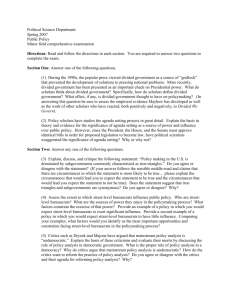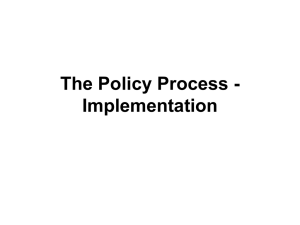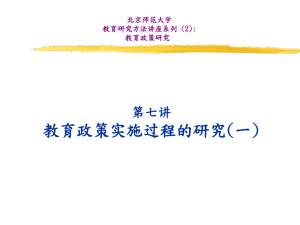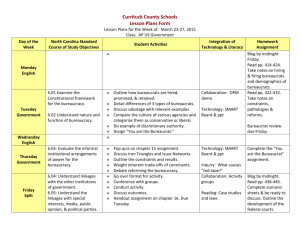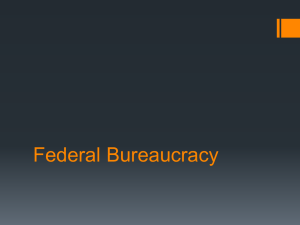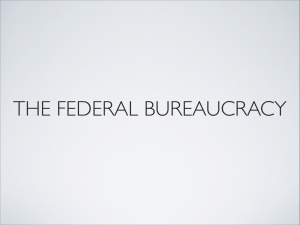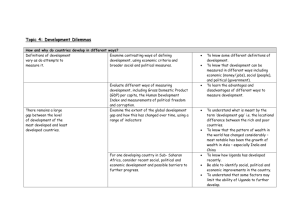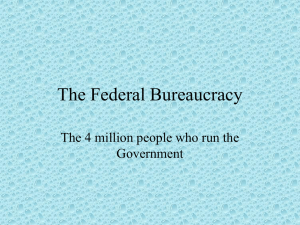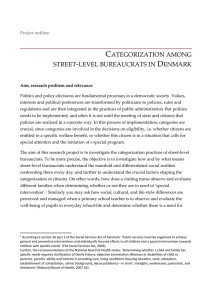3LL3 Development and Public Policy
advertisement
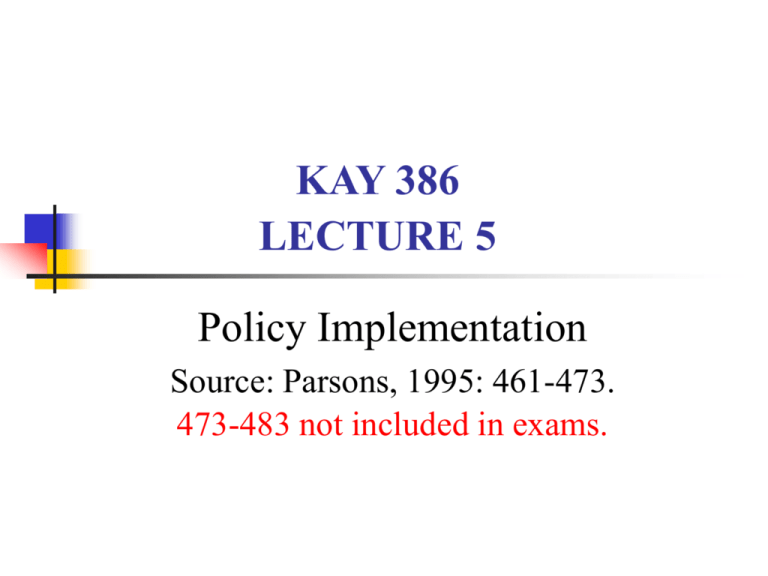
KAY 386 LECTURE 5 Policy Implementation Source: Parsons, 1995: 461-473. 473-483 not included in exams. Course Outline The course slides will be up on the website today. http://yunus.hacettepe.edu.tr/~myildiz/ The e-mail list is still incomplete. Please send a blank e-mail to myildiz@hacettepe.edu.tr as soon as possible (topic: 386) The list that I have (8 out of 15): Melek Arda Vehbiye Dilek Eduard Guzel Murat Elda Implementation: Definitions Studying implementation is studying change How does change occur? Study of the political system inside and outside the organization What motivates implementors? Policy implementation ..a process of interaction between setting of goals and actions for achieving them (Pressman and Wildavsky) ..encompasses those actions that are directed at the achievement of objectives of policy decisions (van Meter and van Horn) Source: Davis, “Influencing PP through Research” Implementation An important stage in the policy process Task of translating policy intentions into outcomes Involves participation by a number of stakeholders Reflects intention of governments to act Examples of policy implementation Policy Possible implementation scenarios Electricity available to all citizens 1. Creation of a public enterprise (direct provision) 2. State regulation of private companies Cleaner water 1. Ban of using certain products (regulation) 2. Possibility to buy the “right” to pollute (market creation) Prevention of heart disease 1. Advertising in the media 2. More hours for physical activities in schools (standard-setting) Implementation: Definitions Policy-making does not come to an end once a policy is set out or approved. Policy is being made as it is being administered and administered as it is being made. Black-Box Model What is happening between input and output? Problems of implementation were rarely analyzed. Bureaucrats are not just neutral public servants Development of Implementation Studies The analysis of failure (Early 1970s) Rational (top-down models) Bottom-up critiques of the top-down model Hybrid Theories: Implementation as: Evolution Mutual adaptation Learning, exploration Inter-organizational analysis, etc. Perfect implementation Preconditions (Gunn) no constraint from external environment availability of adequate time and sufficient resources direct relationship between cause and effect Perfect implementation Preconditions (Gunn) single implementation agency, not dependent upon other agencies complete understanding of, and agreement upon, objectives specified tasks to be performed by each participant Perfect implementation Preconditions (Gunn) perfect communication among, and coordination of, various elements in the program perfect obedience demanded and obtained by those in authority Example: Village Towns (Köykent) in Turkey (Marın, 2005) Objective A policy intervention that facilitates changes in the socioeconomic structure and cultural values of the rural population. The establishment of towns with industrial and agricultural functions across rural Turkey. Agents in this transformation Politicians have similarly been obsessed with the idea of rural socioeconomic development emphasizing the role of small urban centers in this process Evaluating Failure in Village Towns None of the Village Town projects produced desired outcomes. There are a number of factors that caused this outcome: an unstable political environment of some 20 years, ignorance of the socioeconomic structures in project areas, impractical program design failures to accurately evaluate the importance of local citizen participation for the success. As a result most of the projects failed as soon as they began. Rational (Top-down model) Effective implementation is required Getting people to do what they are told Deliberately excluding all emotions and motivations A good chain of command A healthy system of control and communications A system of resources to do the job Minimizing conflict and degeneration But “everything degenerates in the hands of men” When do things go right? Criticisms to the Rational Model Implementation is not a perfect line of causation (x causes y) There is too much emphasis on the definition of goals from the top (rather than role of workers on the line) This model excludes any consideration of how real people actually behave Implementers make policy as well (discreation) The interaction of bureaucrats with their “clients” at street level Is it right for teachers and police to make policy? Interpretation of rules Michael Lipsky’s street-level bureaucracy model Lipsky’s book entitled Street-level Bureaucrats (1980) has been viewed as the leading challenge to the topdown model of policy implementation models and the starting point of bottom-up model. Michael Lipsky’s street-level bureaucracy model Lipsky “argue(s) that public policy is not best understood as made in legislatures or top-floor suites of high ranking administrators, because in important ways it is actually made in the crowded offices and daily encounters in street-level workers.” And “the street-level bureaucrats, the routines they establish, and the devices they invent to cope with uncertainties and work pressures, effectively become the public policies they carry out.” (Lipsky, 1993, p. 382) Michael Lipsky’s street-level bureaucracy model Lipsky underlines that in implementing policy at street level, front-line workers are confronted with conflict and ambiguities. These may include Inadequate resource and unsatisfactory working condition, e.g. large classes for teachers, huge caseloads for social workers, dangerous and hostile neighborhood for police officers. Unpredictable, uncooperative, skeptical clients Unclear and ambiguous job specification and guidelines. Michael Lipsky’s street-level bureaucracy model Confronted with these inadequacies and uncertainties, street-level bureaucrats derive coping strategies or even survival strategies to deal with the unaccommodating working situations. Lipsky point out that in daily “client-processing” routines, street-level bureaucrats in fact have considerable amount of powers and discretions at their disposal, which may lead to substantial deviations from, if not complete alterations of, official and top-down policy specifications. Alternative Models (Elmore) Forward Mapping (top-down) Control over people and resources are not enough for successful implementation is only a myth Not the nature of the implementation process Backward Mapping (bottom-up) What really important is the relationship between policy makers and policy deliverers Begin at the phase when the policy reaches its end-point Then analyze and organize policy by taking into account organizational and political environments Policy-action continuum Problems conflicts over values, issues, and preferences network of activities and actors negotiations, bargaining, and compromise Policy-action continuum Problems values and belief systems as well as professionalism of actors policies may deliberately be made ambiguous Implementation failure Causes different values, perspectives and priority of organizations policies altered through process of delivery best bargainers (negotiators) get what they want Implementation failure Causes hierarchical control difficult to obtain lack of capacity to mobilize target population powerlessness of government underestimation of complexity and difficulty of coordination Implementation failure Causes resistance from bureaucrats and officials gap or breakdown between tasks and agencies changes in the environment beyond the direct control of policy makers Synthesis The top-down and bottom-up synthesis approach: It characterizes theoretical orientations perceiving implementation as process of constituting coalition, structuration, networking, learning or institutionalization, within which various parties in a specific policy domain/area strive to realize a policy, program or project. Implementation as a Political Game Conflict is not dysfunctional Deal-making is acceptable Bargaining and persuasion under conditions of uncertainty Actors are trying to win as much control as possible Groups and individuals seek to maximize their power and influence during implementation On the contrary, it is essential in acquiring and maintaining power Self-interested people playing games Bardach, “The Implementation Game” Book (1977) Blurring of boundaries between politics and bureaucracy Implementation as Evolution Top-down and bottom-up models oversimplify complexity It is an iterative bargaining process between policy enacters and resource controllers Implementation is constrained by the institutional context and the world around the institution Emphasis on power and dependence, interests, motivations and behavior Policy is something which evolves and unfolds over time "you can't take politics out of analysis.“ (Deborah Stone) „What works…is about what works when, where, how, and from whom.“ (Wayne Parsons) “Policy implementation is the social construction of reality: it is a process of meaning making through interpretation.” ( Dvora Yanow) Source: H. Gottweis - SoSe 2oo8
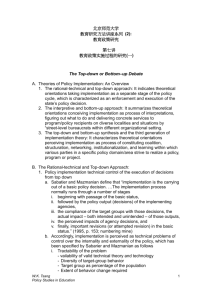
![Read_EPUB Street-Level Bureaucracy Dilemmas of the Individual in Public Service ([Read]_online)](http://s3.studylib.net/store/data/025572064_1-581d0f6d6f955d85248a62c6f7d6b3c2-300x300.png)
